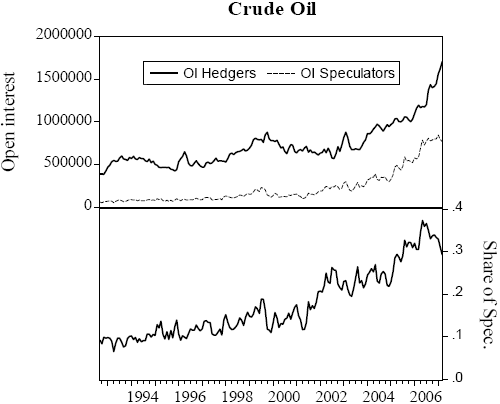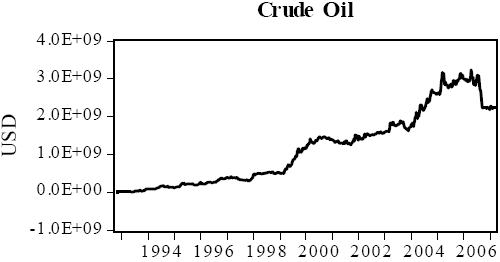Do the big commodity futures speculators make money? If so, how? In their April 2008 draft paper entitled “Returns to Speculators in Commodity Futures Markets: A Comprehensive Revisit”, Christof Sigl-Grüb and Dirk Schiereck investigate the performance and performance drivers for large speculators in 22 commodity markets over the last 15 years. Using aggregate position data for non-commercial traders (large speculators) from the weekly Commodity Futures Trading Commission Commitments of Traders (COT) reports and contemporaneous daily futures price data over the period 10/1/92 to 3/6/07, they conclude that:
- The role of large speculators has increased substantially in recent years in both absolute and relative terms. (See, for example, the chart for crude oil below.)
- Large speculators were profitable over the entire sample period in many markets, with significantly positive returns for 15 of 22 commodities, sometimes via steady gains but mainly due to a number of short run-up periods. (See the second chart below.)
- There is very little evidence that commodity speculators possess short-term forecasting ability in general, but there are limited signs of forecasting ability in a few commodities (gold, copper and natural gas).
- There is evidence that speculators consistently gain by exploiting risk premiums in all commodities. They are consistently on the profitable side of trades when the basis (percentage difference between the current spot price and current nearest-to-maturity futures price) deviates from the value predicted by the theory of storage.
- Net position changes suggest that speculators as a group tend to be trend followers (momentum players).
The upper portion of the following chart, taken from the paper, shows the open interest of commercial traders (hedgers – solid line) and non-commercial traders (large speculators – dashed line) in crude oil futures contracts over the sample period. The lower portion of the chart plots the fraction of total open interest held by non-commercial traders (“Share of Spec.”). The chart shows that absolute and relative speculation has increased substantially in recent years. Trends are similar for many other commodities.

The next chart, also from the paper, plots the approximate cumulative profit (in U.S. dollars – USD) for large speculators from crude oil futures trading based on changes in weekly net position and near-maturity futures price over the sample period. Results indicate that gains and losses tend to be concentrated in relatively short intervals. Gains and losses for many other commodities are similarly spiky.

In summary, large speculators in commodity futures generally do make money by exploiting risk premiums derived from the theory of storage (and perhaps from momentum trading).